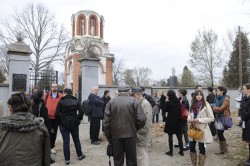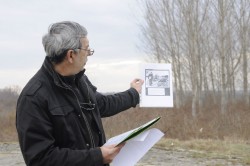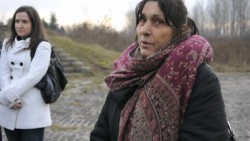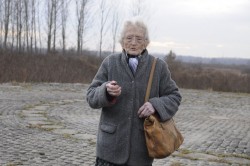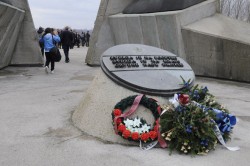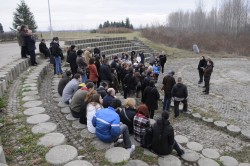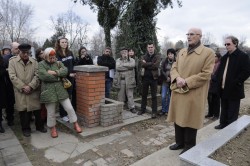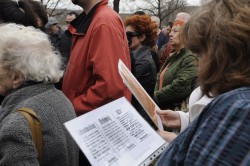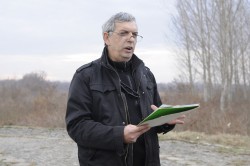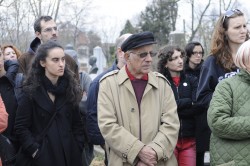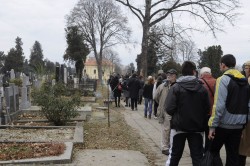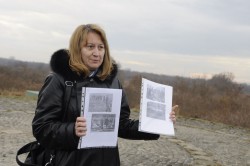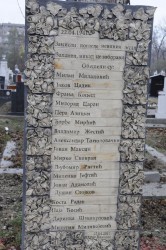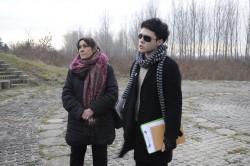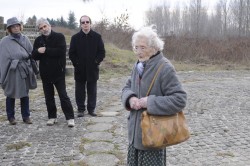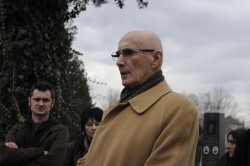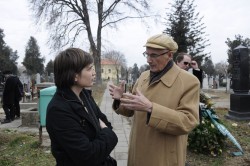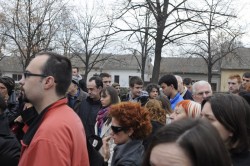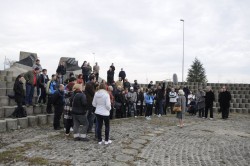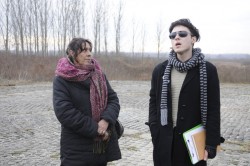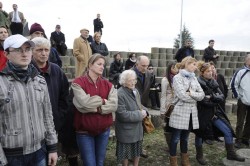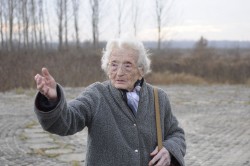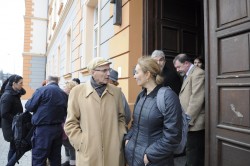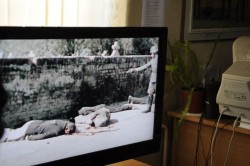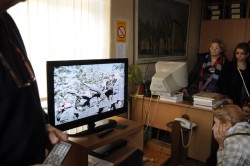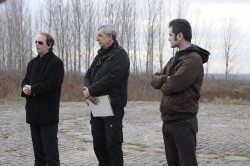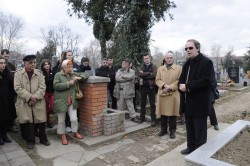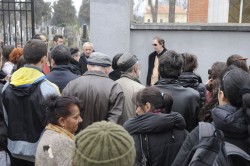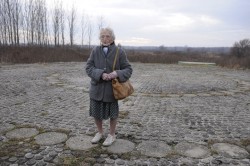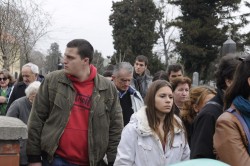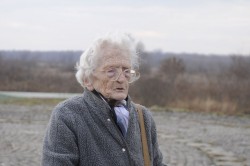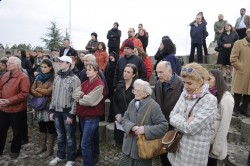Execution site near Jabuka in the vicinity of Pancevo
A visit of the cemetery in Pančevo and the Memorial near Jabuka village, 4 December 2011
The public site visit on 4 December 2011 has been prepared by a working group, that did research on the facts and context of the crimes of the Nazi occupiers and their supporters against the civilian population in Pančevo and Jabuka in 1941. Together with witnesses who covered these events from their own experience and historians from Pančevo, the speakers introduced to those present their researches and visited the Orthodox Cemetery in Pančevo, the Historical Archives and the memorial at the execution site near the village Jabuka (Apfeldorf).
Besides the basic historical facts, the speakers addressed Anti-semitism as an element of the Nazi ideology, the historical role of "Kulturbund" in the nazification of local Germans (Folksdojčeri) and antiziganism in today's society. Activists reported on organized racist violence against Roma in the village of Jabuka.
The tour began in the old cemetery in Pančevo where Srđan Božović (curator-historian of the National Museum in Pančevo) presented a brief history of Pančevo during World War II to all participants. He spoke about the hanging of 36 civilians in this cemetery in April 1941. After this, the audience was addressed by Mr. Vita Sudarski who at the time was a child and who, as a witness of this crime explained the relationships that existed among the local residents of German and Serbian nationality in the years just before World War II.
Milan Radanović talked about other Nazi crimes that took place in the Banat region just before the execution in Pančevo. He also spoke about the structure of those who have committed crimes. It is noteworthy that although most of these crimes were committed by the German regular units, an important role in the implementation of the crimes had the local German population that had gathered around the organization Kulturbund. Kulturbund was established before the war and become Nazi-oriented when ideologically Nazis took over the association in 1938 and early 1939. It is the younger generation of local Germans who embraced the Nazi ideology while studying in Germany after which they conveyed this ideology to other inhabitants of German origin in Vojvodina.
Srđan Božović spoke of the first Nazi concentration camp in the Banat region named Svilara. This camp was located in the suburb of Pančevo on the site of the former factory for the production of silk. This camp was established by the local Germans who organized the camp in order to prevent any potential anti-fascist action which could rise as a result of attack of German troops to Soviet Union. Svilara camp began working on 22nd June. In this camp were detained, tortured and killed mostly communists and their sympathizers, patriots who performed from the position of Serbian nationalists, ordinary citizens, and later Jews (but very few of them because most of them have been already taken to Belgrade camps). The first Nazi concentration camp in Banat was closed in early November 1941 because there was fear that such a place of torture could in the end cause a revolt among local inhabitants.
After, the participants of the public tour went to the execution place near the village Jabuka. Here, Milan Radanović talked in detail about the execution site, which is one of the largest execution sites in the country when it comes to victims of the Second World War. As it is usually stated in the literature, about ten thousand people were killed here. A large number of victims were brought from camp Topovske šupe in Belgrade. During autumn 1941 approximately five thousand men, Jews from Banat and Belgrade, but also over a thousand Roma men were interned there. These men were taken in small groups from this camp and shot mainly at the execution site near the village Jabuka. Srđan Božović explained in detail the ways of killing people at this place. During the conduct, Eva Đorđević testified about the memory of her family members, members of the Jewish community in Belgrade, who fled from Belgrade to Pančevo when the occupation of Belgrade started, from where they were deported back to Belgrade. Her father was imprisoned in the camp Topovske šupe in Belgrade, and murdered later at Jabuka execution site.
Slobodanka Perović spoka about the memorial complex, which was built at the place of liquidation of civilians in the village Jabuka and consists of a monument, place for laying wreaths, the amphitheater and the guard house. The first deficiency in the maintenance of this monument was observed in 1987. From this period this memorial complex intensively decays due to inadequate maintenance. The main obstacle that stands in the way of restoring the memorial complex are chaotic legal property relations. The entire complex is in fact an illegal construction and in this situation it is not possible to obtain a building permit to perform any kind of restauration work.
Borka Vasić and Goran Lazić, Roma rights activists, spoke about the contemporary forms of fascism in the village of Jabuka, where ethnic violence against the entire local Roma population broke out after a tragical case of death that happened during a quarrel between youngsters.
Leader of working group: Ana Vilenica
Speakers: Eva Đorđević (witness), Milan Jakšić (Historical archives of Pančevo, director), Srđan Božović (National Museum Pančevo, historian/curator), Nandor Ljubanović (blogger), Borka Vasić (Roma rights activist), Goran Lazin (activist), Slobodanka Perović (Institute for cultural heritage protection of Pančevo, historian/restaurator), Milan Radanović (historian)
Idea and coordination of public visit: Rena Redle
Organization and production: Kulturni centar Rex/ fond B92
Realized with the support of: Rosa Luxemburg Foundation, Office for Southeast Europe
DOWNLOAD
-
Transcript of the speeches in Serbian language
transcripts/vodjenje_transkript_jabuka_pancevo.doc
